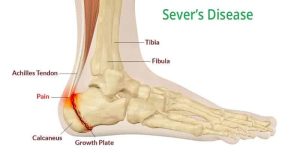
What is it?
Severs disease in pain in the heel in the region where our achilles tendon attaches. Here there is a growth plate where the bone remodels and lays down more bone as children grow taller. This condition is common in children, especially primary and intermediate age, who are very active.
What is the cause?
Severs disease is not a traumatic injury but one that comes from overuse. Children’s growth plates in the heel remains open until at least 14 years of age. When they have growth spurts the bone growth is faster than that of the muscles and tendons. The muscles then increase the tension on the growth plate causing irritation and inflammation. This coupled with a child who is actively participating in running and jumping sports increases the impact pressure on this open growth plate in the heel.
How can I treat this?
Offloading and Pain management
Firstly it’s important to offload this area and let the acute inflammation have a chance to settle. Putting some heel lifts in shoes is also helpful as this means there is less pulling on the insertion in the heel during walking.
Strengthening
Getting a strength program that is specific to your child’s needs is a good idea as often there is some compensation happening from the pain and then imbalances can occur.
Stretching
Children with severs usually have very limited ankle flexibility and stretches can help to address this issue. The issue is getting some stretching without too much pulling and making it worse.
Taping
In the clinic we see that using Rocktape does lessen the pain and allow more function so is a good idea to think about when managing pain or returning to activity.
Can this be prevented?
50% of overuse injuries in children and adolescents are reported to be preventable. Prevention is about mediating risk factors and research show 87% of children who reported heel pain were involved in running and jumping sports.
I think stopping children doing these activities because it ‘might’ happen is not a good idea. If there are signs that there is pain in the base of the heel then acting to manage load quickly, in the short term is a great plan.
Thinking about the amount of rest an active child has is also important. Often times of unorganised activities and playing with friends results in trampoline jumping and running around which is just more load.
Fares, M. Y., Salhab, H. A., Khachfe, H. H., Fares, J., Haidar, R., & Musharrafieh, U. (2021). Sever’s Disease of the Pediatric Population: Clinical, Pathologic, and Therapeutic Considerations. Clinical Medicine & Research, 19(3), 132–137. https://doi.org/10.3121/cmr.2021.1639
